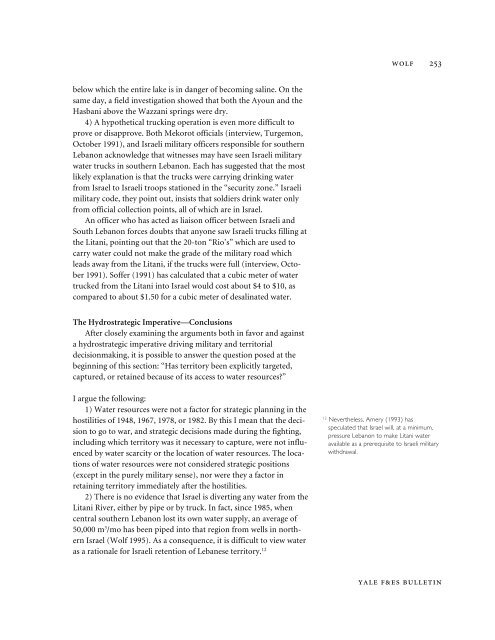Hydrostrategic Decisionmaking and the Arab ... - Yale University
Hydrostrategic Decisionmaking and the Arab ... - Yale University
Hydrostrategic Decisionmaking and the Arab ... - Yale University
Create successful ePaper yourself
Turn your PDF publications into a flip-book with our unique Google optimized e-Paper software.
WOLF 253below which <strong>the</strong> entire lake is in danger of becoming saline. On <strong>the</strong>same day, a field investigation showed that both <strong>the</strong> Ayoun <strong>and</strong> <strong>the</strong>Hasbani above <strong>the</strong> Wazzani springs were dry.4) A hypo<strong>the</strong>tical trucking operation is even more difficult toprove or disapprove. Both Mekorot officials (interview, Turgemon,October 1991), <strong>and</strong> Israeli military officers responsible for sou<strong>the</strong>rnLebanon acknowledge that witnesses may have seen Israeli militarywater trucks in sou<strong>the</strong>rn Lebanon. Each has suggested that <strong>the</strong> mostlikely explanation is that <strong>the</strong> trucks were carrying drinking waterfrom Israel to Israeli troops stationed in <strong>the</strong> “security zone.” Israelimilitary code, <strong>the</strong>y point out, insists that soldiers drink water onlyfrom official collection points, all of which are in Israel.An officer who has acted as liaison officer between Israeli <strong>and</strong>South Lebanon forces doubts that anyone saw Israeli trucks filling at<strong>the</strong> Litani, pointing out that <strong>the</strong> 20-ton “Rio’s” which are used tocarry water could not make <strong>the</strong> grade of <strong>the</strong> military road whichleads away from <strong>the</strong> Litani, if <strong>the</strong> trucks were full (interview, October1991). Soffer (1991) has calculated that a cubic meter of watertrucked from <strong>the</strong> Litani into Israel would cost about $4 to $10, ascompared to about $1.50 for a cubic meter of desalinated water.The <strong>Hydrostrategic</strong> Imperative—ConclusionsAfter closely examining <strong>the</strong> arguments both in favor <strong>and</strong> againsta hydrostrategic imperative driving military <strong>and</strong> territorialdecisionmaking, it is possible to answer <strong>the</strong> question posed at <strong>the</strong>beginning of this section: “Has territory been explicitly targeted,captured, or retained because of its access to water resources?”I argue <strong>the</strong> following:1) Water resources were not a factor for strategic planning in <strong>the</strong>hostilities of 1948, 1967, 1978, or 1982. By this I mean that <strong>the</strong> decisionto go to war, <strong>and</strong> strategic decisions made during <strong>the</strong> fighting,including which territory was it necessary to capture, were not influencedby water scarcity or <strong>the</strong> location of water resources. The locationsof water resources were not considered strategic positions(except in <strong>the</strong> purely military sense), nor were <strong>the</strong>y a factor inretaining territory immediately after <strong>the</strong> hostilities.2) There is no evidence that Israel is diverting any water from <strong>the</strong>Litani River, ei<strong>the</strong>r by pipe or by truck. In fact, since 1985, whencentral sou<strong>the</strong>rn Lebanon lost its own water supply, an average of50,000 m 3 /mo has been piped into that region from wells in nor<strong>the</strong>rnIsrael (Wolf 1995). As a consequence, it is difficult to view wateras a rationale for Israeli retention of Lebanese territory. 1212Never<strong>the</strong>less, Amery (1993) hasspeculated that Israel will, at a minimum,pressure Lebanon to make Litani wateravailable as a prerequisite to Israeli militarywithdrawal.YALE F&ES BULLETIN
















